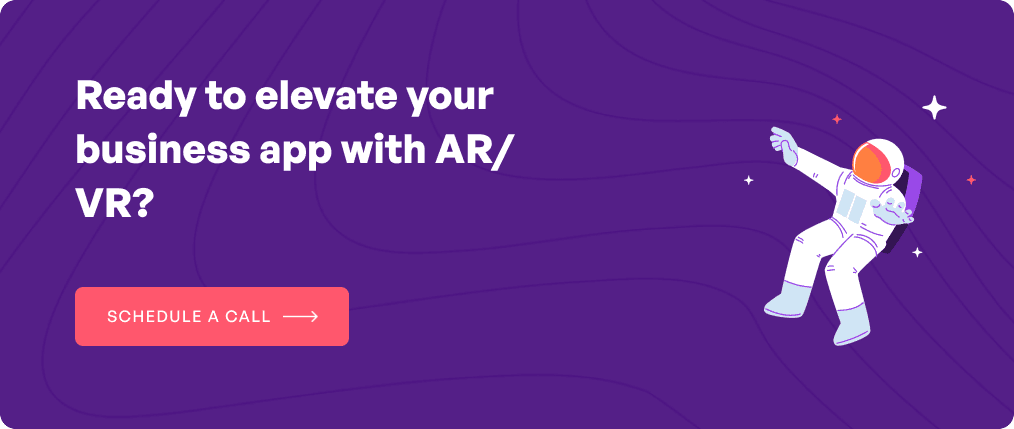The year was 1968 when Harvard Professor Ivan Sutherland and his student Bob Sproull created history by developing the first AR/VR helmet. It was called The Sword of Damocles and it functioned through a head-mounted display. After this, mankind saw an extraordinary feat of time travel when AR/VR transformed from what previously seemed like science fiction to powerful technologies today, offering unprecedented levels of interactivity. Several industries in recent times have acknowledged this potential and figured out that AR/VR can be a turning point in their reputation and revenue.
For instance, it boosts engagement by ensuring realistic and stimulating online experiences for end-users. This is exactly what you too can achieve in your business with us at Simublade where developers are proficient in building AR and VR applications. It will change the way your brand interacts with customers in terms of guidance, directions and product information.
Owing to these benefits, the AR and VR users across the world are poised to reach 3,728 million in 2029 and the user penetration will be 56.5% by then. Below is another gripping statistics:
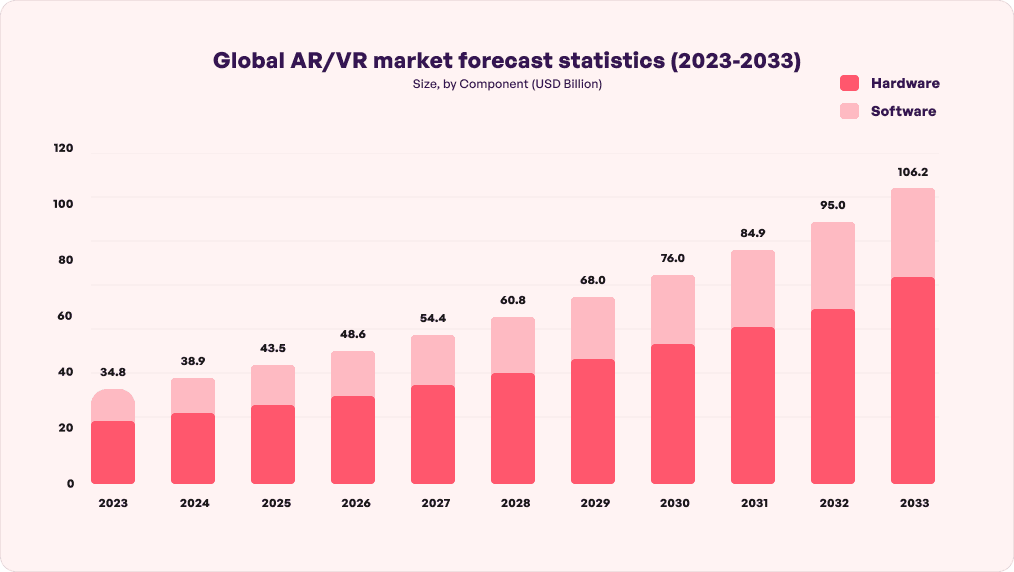 So, it is a good idea for businesses to consider this technology as a value-adding asset and invest in it.
So, it is a good idea for businesses to consider this technology as a value-adding asset and invest in it.
This article gives you an idea of AR and VR definition along with other information on how to build an AR VR app to transcend the confines of reality and stay ahead in the tech race.
Table of contents
What is Augmented Reality (AR) ?
Augmented reality lets users interact with digital products in the real time. This means, 3D images, videos, and special effects are superimposed around us in actual locations and are visible via special AR glasses, phones and tablets. Immersive sounds are also included which make up for 50% of the entire experience.
AR is truly a futuristic way to let users enjoy the overlap of digital and physical universes. This is quite beneficial since 57% of users have reported that they are more likely to buy from a brand that offers AR exposure. For example, AR can display the image of a sofa in your living room to help customers know the dimensions, look, and feel of it for an informed purchase decision.
E-commerce giant Amazon has already integrated AR to allow a ‘virtual try on’. Other examples include driving directions on your windshield, trying on makeup products virtually, or exploring landmarks through AR-guided tours.
Wondering how does it work? Well, an AR software is loaded in a camera-equipped device which leverages motion detectors and lenses to figure out the surrounding environment.
What is Virtual Reality (VR) ?
Virtual reality creates a whole new simulated 3D environment where everything appears to be real and can be explored in 360 degrees. Users can interact in this computer-generated, artificial society via goggles or a headset with a stereoscopic screen integrated inside a mobile application.
Here’s how it works. Motion sensors present in these devices pick up movements like walking steps or head-turns and adjust the illusionary space accordingly. Gloves are also a part of the virtual reality experience, equipped with force-feedback, for a sense of touch to hold, move or turn objects.
Let’s take a glimpse of what exactly VR in an app feels like – users can travel to a fancy destination or just outside their homes with vibrations and lit-up pavements at every footstep. They can then enjoy birds chirping and fluttering over their heads, rustling bioluminescent leaves, a robot walking past, a cafe with holographic menus to be swiped with fingers and a massive colossal dome with shifting patterns. When incorporated in gaming, education or relaxation apps, the brain is easily tricked into thinking that all of these are true since VR is layered with reality to transport users to another world.
Given how the technology is surpassing the limits of the material universe, 73.6 million VR headsets are predicted to be sold in 2026 across the globe. The key driving factors are technological advancements, cloud services, and of course, the mindblowing sensory emotions and experience.
Let’s see the basic differences between AR and VR:
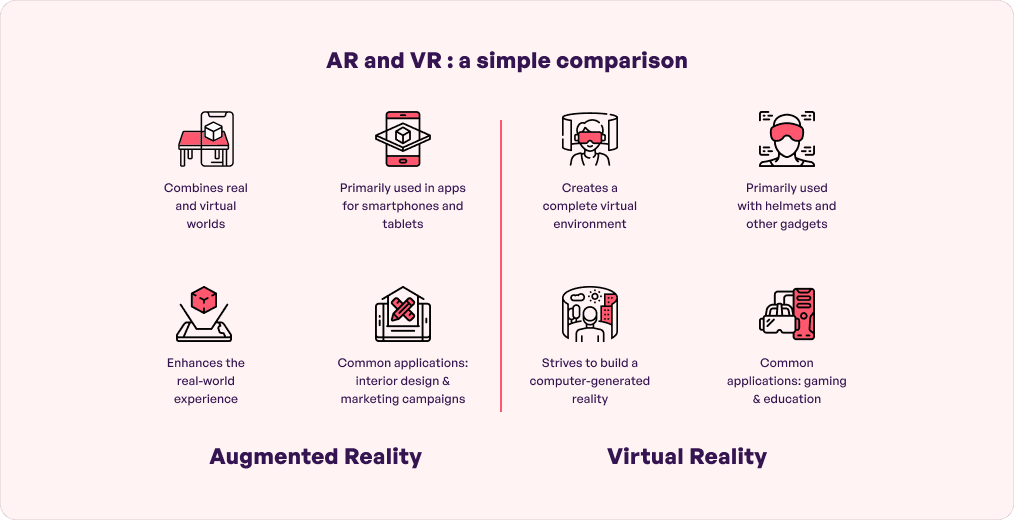
What are the benefits of AR VR app development?
Organizations must be abreast with the benefits of AR and VR to rest assured that investing in mobile apps integrated with this technology is indeed a game-changing affair.
The main advantage is increased interactivity and engagement of the human senses generated via visual, auditory, and tactile stimuli from the sounds and graphics. It creates an online experience via apps which is enjoyable and worth users’ time. Other benefits are :
- in-depth consumer insights from their interactions
- increase in conversion rates due to informed decisions power
- incredible accessibility with handsets and headgears
- boosts the perceived value of the brand and services
- helps you shine in the saturated market
These AR VR benefits span across all industries which ultimately enhances customer satisfaction and loyalty while keeping your brand at the forefront of users’ minds.
 The next section talks about the different use cases across multiple sectors.
The next section talks about the different use cases across multiple sectors.
What are common AR VR use cases?
The below use cases are a step towards a digitally augmented world touching both personal and professional lives by transforming the way we learn, connect, travel, and have fun. Thus, embracing the technology by building an AR VR app will help you come across as a brand that is technically sound, appreciates precision and launches creatively compelling solutions to serve all types of audiences. Here’s a look.
Gaming
Apps like Pokémon Go and Snapchat use AR technology for real-world engagement. VR is extensively used in interactive games like SuperhotVR. Users can also watch NBA and NFL events and sports via VR headsets in their living room while enjoying the feel of a stadium with 360 degree views.
Real estate
With AR VR, potential buyers can even step into a virtual property to get an immersive view of the architecture, layout, decor, design, and overall vibe of a real one without on-site visits. This saves plenty of time and effort for both the seller and the customer and opens opportunities for real estate companies to showcase maximum properties.
Education
The meaning of education has been completely changed through AR VR with experiential learning, live interactive classes, and visits to historical landmarks or attending field trips virtually right from the classroom. Further, digital information can be layered in physical textbooks to help students interact with content in new ways.
Healthcare
The healthcare sector uses the technology to ensure deep relaxation, attention-shifting, and reduced chronic pain awareness. Surgeons can also prepare themselves for a surgery by practicing the operation virtually and doctors benefit from better explanation of diagnosis and treatment plans with AR and VR.
Architecture and interior design
Architects and home interior designers leverage the potentials of AR and VR technologies for 3D models of buildings and decor to offer a ‘walk through’ to their customers before they are physically at work. This ensures maximum satisfaction and deal closures.
Web 3.0
AR and VR are the core standards of Web 3.0, the newest version of the internet, to ensure digital content is experienced in a highly immersive environment.
Automobile
Automobile leaders like BMW and Land Rover have been using VR for the longest time to see designs that are alternative to POP models. This was basically prompted by the 2020 corona pandemic to save materials and man hours.
Marketing campaigns
Businesses are using AR and VR to offer revolutionary marketing campaigns or platforms where consumers can try virtual products before purchasing them. One good example of AR VR is the virtual campus tours with details of amenities offered to university students to take marketing to the next level.
If you are still in doubt, here are a few popular applications that are already maximizing AR and VR : Google Maps, Holo, Quiver, Microsoft Math Solver, IKEA Place, and JigSpace.
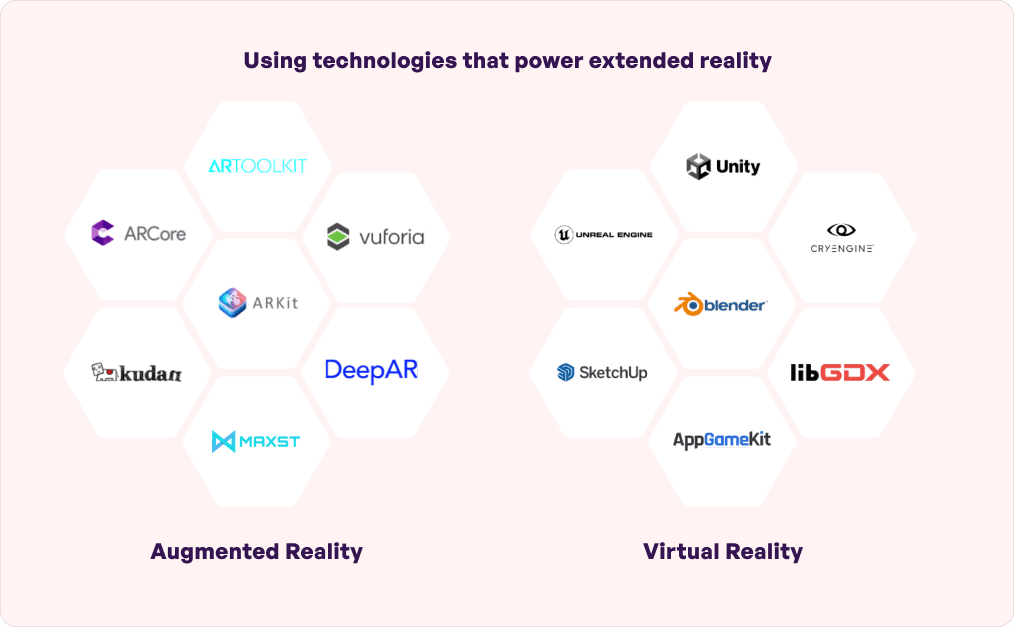
The core principles of embedding AR and VR in mobile apps
Real time interactions, user-centric designs, performance optimization, and spatial awareness are integral to successful AR VR app development. These ensure element integrations, intuitive AR VR experience, a balance between device capabilities and graphical fidelity, and location-based AR utilization to interact with the real world, respectively. All of these combined can ensure an accurate compatibility of virtual and actual objects that results in business progression.
At Simublade, our developers put these principles at the center of the AR VR development services to ensure beautifully designed location-based and sensor-based mobile and desktop apps. We also offer mixed reality experience design, which was predicted by Forbes in 2024, through app flow and unique interfaces.
Now that you know the potentials of both these technologies and how they can be a treat to the eyes, let’s see the process of developing an AR and VR app.
A detailed overview of Simublade’s AR VR app development
Our best-in-class developers strive to give your customers a taste of innovation by changing the meaning of their digital journey. This is possible due to our meticulous AR VR app development process, coupled with technical and market expertise, which ensures 50% increase in average user engagement and boosts sales conversions by 25%. Read on to see the step-by-step details of how we build industry-ready AR VR solutions that shape tomorrow’s landscape.
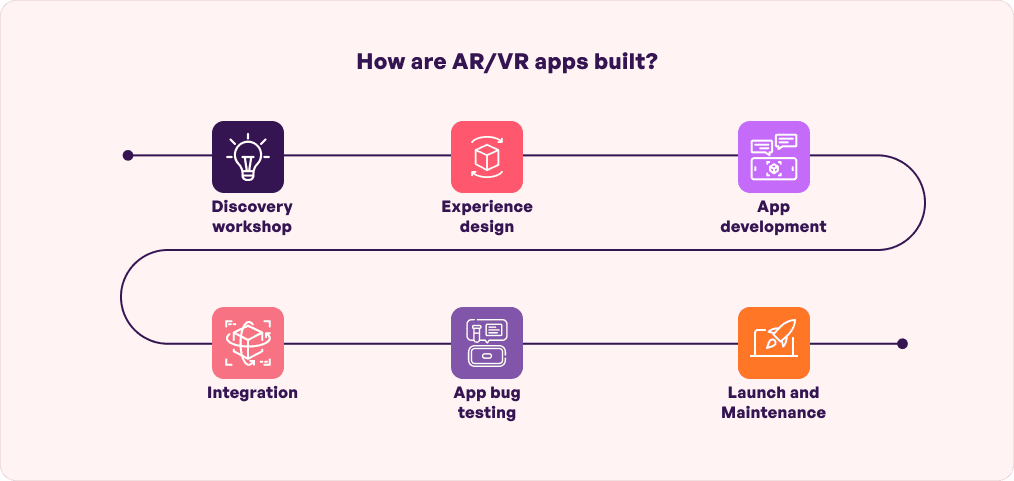
Stage 1: Discovery workshop
During the discovery workshop phase, we understand your target audience, business goals, and potential challenges. A close collaboration like this helps us tailor the most effective AR VR solution to help your business survive and thrive.
Stage 2: Experience design
Our highly skilled and talented team has an eye for detail which helps them craft captivating experiences packed with features like intuitive interfaces and seamless navigation. They also conduct a design sprint session before this, to fast forward to the future and see how the finished product will look like.
Stage 3: App development
Cutting-edge AR and VR technologies like ARCore, DeepAR, Vuforia, VisionOS, Google AR-Code, Solidworks, Unity, SketchUp and Unreal Engine along with multi-framework and toolsets are used, just like in Apple Vision Pro, to build the immersive mobile application. It helps take your business from vision to virtuality flawlessly promising competitive advantages.
Stage 4: Integration
Simublade’s dedicated AR VR developers integrate advanced functionalities while ensuring smooth compatibility across all devices. This offers a new dimension to user experience which significantly boosts customer attraction and retention.
Stage 5: App bug testing
Our end-to-end rigorous testing procedure identifies and fixes glitches, gaps, and bugs to deliver superior results. Businesses can reach our developers without hesitation post app launching to discuss and resolve discrepancies.
Stage 6: Launch and maintenance
We help release the app in the Play Store or App Store but do not stop there. Businesses are offered ongoing support to ensure the AR and VR product is up-to-date, responsive, and well-optimized as per the evolving needs.
Now that you know the stages, it is recommended to get a deep-level understanding of what you want to offer to your customers. Once you have the clarity, go through Simublade’s offerings, case studies, portfolios, and client reviews to confirm if they are a good match to your objectives. This will help you maximize your time, effort, and money in the best way possible.
What is the cost of building AR VR applications?
The cost to build an AR VR app ranges between $50,000 to $1,00,000. It can be as low as $20,000 and as high as $2,00,000 as well. The amount will entirely depend on design complexity, technologies integration, features, developers’ team size and location, and the number of platforms on which the app will be deployed.
Adjusting the investment in certain areas depending on business priorities can help stay within your set cost of AR VR app development budget.
3 Future AR VR trends businesses must know
Have a look at exciting trends of 2024, and no doubt beyond, that offers a wealth of opportunities when it comes to AR VR applications. Staying up-to-date will help you launch remarkable solutions way before competitors do. Take a look.
1. GenAI integration
AR VR combined with generative AI will help produce immersive artwork, avatars that act like chatbots offering product suggestions, and voice assistants in gaming. AI’s powerful transformative abilities will further help devices understand the users’ environment with more precision and offer creative experiences, blurring the line between virtual and real. Lastly, AI can lower the time taken to build an AR VR app which helps launch the solution promptly.
2. AR VR and 5G
5G can deliver up to 20-Gbps and supports 100 X more traffic capacity than 4G without compromising on the network quality. Combining this with VR AR will ensure high-speed data transfer, better loading time, and efficiency even in low-powered areas. For instance, displaying 3D CAD/BIM models in construction sites where workers can see the project before working on it saves millions of dollars.
3. Advanced AR VR displays
AR VR users are already witnessing display technologies improving in form factor, focus cue, resolution, and pass-through capabilities. Lets understand with two examples:
- Diffractive waveguides and refractive waveguides in the optimal projection systems are significantly being improved in the AR technology.
- Fast LCD is especially a rising choice for VR displays due its high-end production stability for ultra-modern performance.
Altogether, these AR VR trends would play a key role in helping build captivating and realistic scenarios for users.
Conclusion
In a nutshell, AR and VR are proving their potentials individually. Put together, they can heighten businesses in terms of profits and popularity. Talking about the current advancements, well in 2024, Apple’s flagship VR device, Meta Quest 3 and Meta Quest Pro were released. Hopefully, we will see Apple’s AR glasses in 2025 that wish to offer highly upgraded and refined visuals. In the meantime, businesses can do their share of research to get a clear idea of the potentials of AR VR.
From there, our developers at Simublade can take the lead in aligning strategies with your goals to build solutions that work in your interest. With our AR VR app development services, we can successfully integrate visual recognition, and face and gesture recognition to power the extended reality.
FAQs
Q. How much does it cost to develop an AR VR app?
Ans. The cost to build an AR VR app is between $50,000 to $1,00,000. It can be as low as $20,000 and as high as $2,00,000. The price depends on app complexity, design systems, number of platforms where the app is being deployed, and the location and team size of the development company.
Q. How long does it take to develop an AR VR app?
Ans. Approximately, it takes 133 to 533 hours to build an AR VR app. The timeline depends on custom features, platform, technology integration, and developers’ skill set.
Q. Why choose Simublade to develop an AR VR app?
Ans. Simublade’s AR VR app development services are trusted globally for our developers’ market expertise, technical prowess, and exceptional skills and experience. We guarantee a competitive edge with a proper design sprint session followed by implementation of multi framework languages and toolsets similar to that of Apple Vision Pro and Unity.



